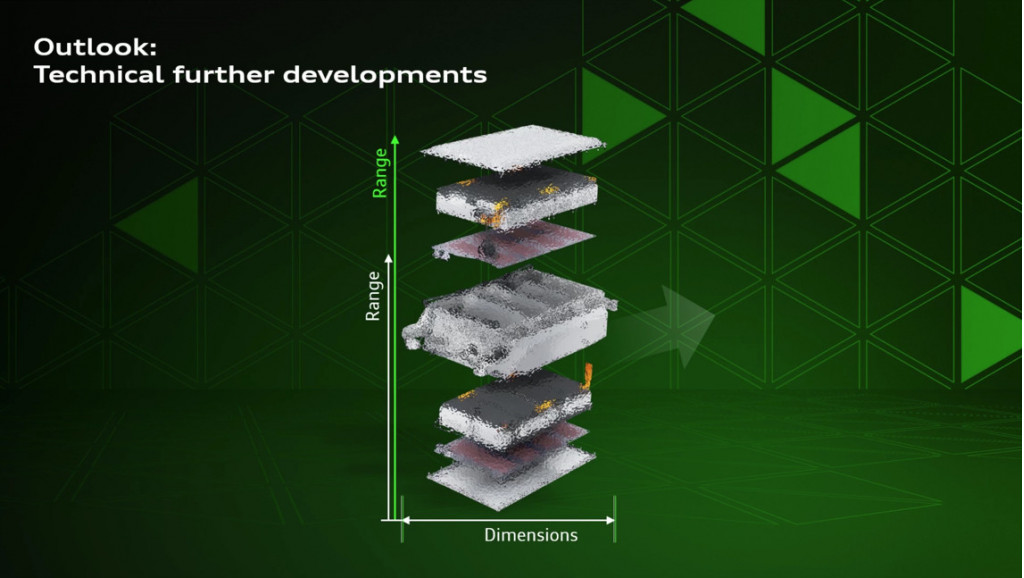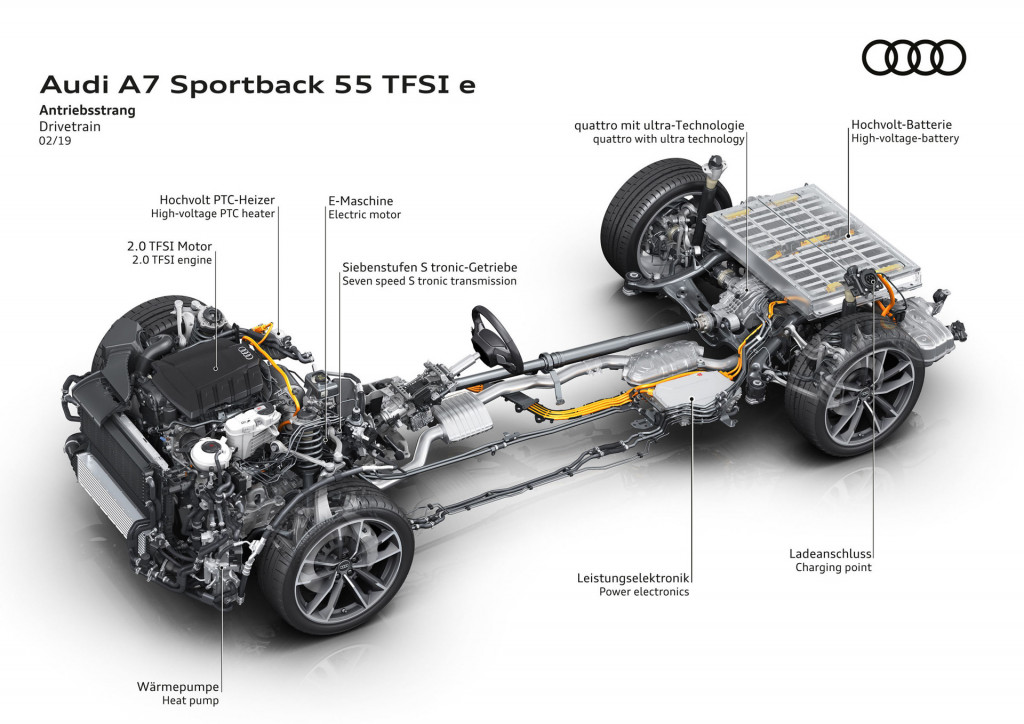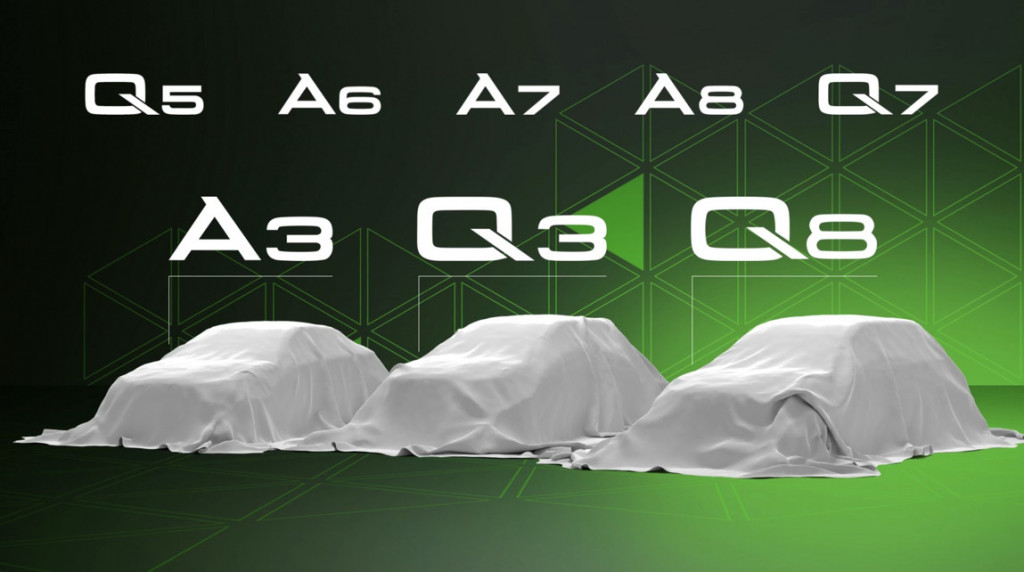Audi does not see plug-in hybrids as a transitional technology to be quickly made redundant by fully electric vehicles.
Instead, the German automaker is suggesting that it sees them as the future of the internal combustion vehicle, and it’s looking ahead to more plug-in hybrid models in the lineup—including performance plug-in hybrids.
Coming from Audi Sport, these models, likely led by a next-generation RS 4, will provide all the attributes expected from a classic RS models, combined with zero-emissions driving potential, Audi officials said in a tech talk earlier this week. And as the technology leaders showing the potential of PHEV powertrains, they might be the first to take advantage of battery advances.
Taking some of its PHEVs in a performance direction won’t change the focus on increasing all-electric range in the near future. Audi sees 80 kilometers (about 50 miles) as the target for the next iteration of its plug-in hybrid models, while retaining the same battery pack sizes.

Audi PHEV range will increase with energy density gains
The ideal electric range for a PHEV is right around that, Audi officials told Green Car Reports, because it covers the daily-driving needs of its customers in the U.S. and around the world.
Currently, Audi has three plug-in hybrid models set for the U.S. The Audi Q5 and A8 plug-in hybrid models went on sale earlier this year, and for 2021 they’re rated at 19 and 18 all-electric miles, respectively (we’ve seen better than that in a first drive). The third model, the A7 plug-in hybrid, will reach dealerships later this fall.
With the average American driving about 29 miles a day, Audi says a PHEV owner could drive to work, charge to full there, and drive back home without using any gasoline during the week.

2021 Audi A7 Sportback 55 TFSI e plug-in hybrid
For many families, plug-in hybrids offer the perfect mix for people to commute all or mostly tailpipe-emissions-free on the weekdays, then to seek out adventure on the weekends without the constraints of still-limited fast-charging networks.
The Q5 and A7 PHEVs also qualify for California HOV lane access, and all three of them qualify for a $6,712 federal EV tax credit.
Audi emphasizes that when you apply that tax credit, the effective price of the Q5 plug-in hybrid, for instance, costs less than that of the performance-oriented SQ5 model with a similar level of features, and performance to match.
Audi has aimed to keep cargo capacity essentially the same as for its other models, and towing capacity remains the same.

2020 Audi Q5 plug-in hybrid (Euro-spec) - first drive, October 2019
All three of Audi’s U.S.-bound PHEV models come with a 14.1-kwh battery pack and 134-hp permanent-magnet electric motor sandwiched between the engine and transmission, but between them they offer two different mechanical layouts. The Q5 and A7 have a 2.0-liter turbo-4 and a 7-speed dual-clutch automatic gearbox, making a combined 362 horsepower and 369 pound-feet of torque, while the A8 has a 3.0-liter twin-turbo V-6 and an 8-speed automatic transmission.
These are designed for four-season use, and electric range shouldn’t drop to near-nothing in the winter, as it does in some PHEVs. Audi notes that its battery packs and electric propulsion systems are thermally managed with a dedicated cooling circuit, and an integrated heat pump recovers waste heat from high-voltage components and can generate up to 3 kw of heat per 1 kw of electrical energy used.
Audi also confirmed that plug-in versions of the Q3, A3, and Q8 will be detailed in the next few weeks, although none of those models are expected to be U.S.-bound.

More Audi PHEVs coming soon - September 2020
For Audi, plug-in hybrids make sense and fill in the gaps in its plug-in lineup not yet covered by its fully electric vehicles—already including the E-Tron SUV and E-Tron Sportback, and soon to include the Q4 SUV and Sportback, plus the E-Tron GT performance EV.
It’s also commanding some impressive demographics for its Q5 PHEV. Buyers of that model have a higher income and are more college-educated than buyers of the conventional Q5 models—and they skew more male. In short, it’s people who want a known product but with a green boost.
Audi is seeing a take rate of 30% to 50% for its PHEV models in Germany, but in the U.S. capacity for the Q5 PHEV is capacity-constrained to about 10% of total sales volume. For all three plug-in hybrids combined—Q5, A7, and A8—it’s expecting a 10-15% share of sales.
Audi anticipates that 30% of its lineup globally will have charging capability by 2025—whether that be in the form of a PHEV or EV.













